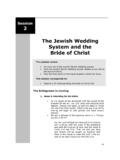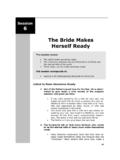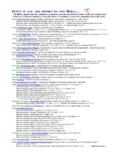Transcription of Esther and the Bride of Christ - thectp.org
1 Session 4. Esther and the Bride of Christ This session covers: Esther as a picture of the end-time Bride The story of Esther The types and shadows in the book of Esther The Bride of Christ in the end times This session corresponds to: Session 4 of Understanding the Bride of Christ CDs A Picture of the End-Time Bride 1. The book of Esther is a magnificent allegory that de- scribes the end-time Bride of Christ . Esther is more than an amazing story of a young Jewish girl who saved her people. This book reveals the mighty call that the Lord has granted to His end- time Bride , the rewards of pursuing this glorious rela- tionship, and the preparation that is required to part- ner with Jesus in the end times.
2 In this session and the next, we will use the book of Esther as the lens through which to view the call, purpose, preparation, position, and role of the end- time Bride of Christ . 2. Before we begin, we need to understand a few impor- tant truths about allegorical interpretations. An allegory is a story in which people, things, and events have a hidden or symbolic meaning. Allego- 43. 44 Understanding the Bride of Christ ries are often used for teaching or explaining moral principles and spiritual truths. The word allegory is used only once in the Bible: when Paul says that Hagar and Sarah are an allegory of the old covenant and the new covenant (Gal.)
3 4:23-24, KJV). Despite only being mentioned by name once, allegories abound in Scripture. Paul, for example, showed that the marriage relationship was a picture of Christ and the church (Eph. 5:22-32). And most scholars believe that the Song of Solomon is an allegory of Jesus and His Bride . The primary way to interpret the Bible is through the historical gram- matical approach that takes Scripture at face value. Even so, allego- ries can be very helpful in interpreting the Scriptures as they make complex truths simpler to understand, but you need to be cautious when interpreting them, lest you add meaning to God's Word that was never intended.
4 Whenever we interpret a passage allegorically, however, we must make sure that the truth we are establishing is clearly revealed else- where in the Bible. Because characters in an allegory are often filled with flaws and sinful behavior, they are never a perfect representation of spiritual truths or of the Lord Himself. For example, in the book of Esther , King Ahasuerus is an unre- strained, self-indulgent, immoral world ruler who sought pleasure at any cost. He is a poor moral representation of King Jesus. However, when you disregard King Ahasuerus' character flaws and instead view him simply as a king who is searching for a Bride , he be- comes a symbol of Jesus' quest to find a worthy Bride .
5 The Story of Esther 1. The book of Esther begins with King Ahasuerus hosting two ban- quets. In 483 , after Persia overthrew Babylon and before many of the deported Jews had returned to the land of Judah, King Ahasuerus, the king of Persia, gave a banquet lasting 180 days a full six months for the leaders of the 127 provinces of his kingdom. The king used this lengthy feast with his leaders to plan an upcoming invasion of Greece. At the end of the 180 day banquet, Ahasuerus gave another banquet for all of the people who lived in the capital city of Susa.
6 On he seventh and last day of this banquet, Ahasuerus called his Bride , Queen Vashti, to come before the princes and all the people to display her beauty. She refused and the king was enraged. Because of her rebellion, Ahasuerus issued an unbreakable edict that prohibited Vashti from ever coming into his presence again, stipulating that her royal position be given to another more worthy than she (Est. 1:19). Esther and the Bride of Christ 45. 2. King Ahasuerus searched for a Bride more worthy than Vashti. After some time passes and his anger subsides, Ahasuerus began searching for a new Bride one more worthy than Vashti.
7 His attendants looked throughout the land for beautiful young virgins to bring to Susa so that the next queen might be selected from among them. As the king's law dictated, each of the candidates was required to go through 12 months of preparation: six months of myrrh baths and six months of spices and cosmetics. When the preparation was complete, each young girl would be evalu- ated by the king, and the one who pleased him the most would be chosen as his queen. Esther , a Jew, was one of the candidates. Mordecai, her uncle who raised her after her parents died, carefully watched over Esther during the preparation process.
8 In the king's harem, Esther had great favor with Hegai, the king's eunuch, and he gave her the best that the palace had to offer. After completing the 12 month preparation process, Esther , along with the other virgins, went in for her night with the king. After this evaluation, each young lady was sent to a second harem to wait and see if she had pleased the king. She would not appear before the king again unless he took pleasure in her and requested her by name. As the storyline goes, Esther pleased the king so much that he chose her as his queen. 3.
9 Esther rescued the Jews from certain annihilation. Some time later, Ahasuerus promoted Haman who was from the royal family of the Amalekites, Israel's ancient enemy to second in command. To honor Haman, the king required that everyone in the kingdom bow before Haman and pay homage to him. Mordecai, an observant Jew, would not bow down to him. Thus, Ha- man detested Mordecai and initiated a plot to kill him and all of his people, the Jews. Haman sent a letter to all the provinces authorizing the people to kill all of the Jews in the land. As you would expect, the Jews were terrified and began to cry out for deliverance.
10 Mordecai asked Esther to intercede to the king for the Jews' deliver- ance. Though she did not recognize the threat at first, Esther finally realized what was at stake. If she did not act, her people would be annihilated. Perhaps she had attained royalty for such a time as this (Est. 4:14). Determined to act, yet knowing the consequences of not receiving the king's favor, Esther uttered her now-famous words, If I perish, I per- ish (Est. 4:16). 46 Understanding the Bride of Christ After a three-day fast, Esther approached the king to request that he spare the Jews.











